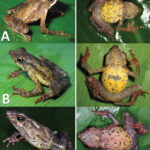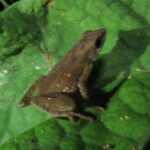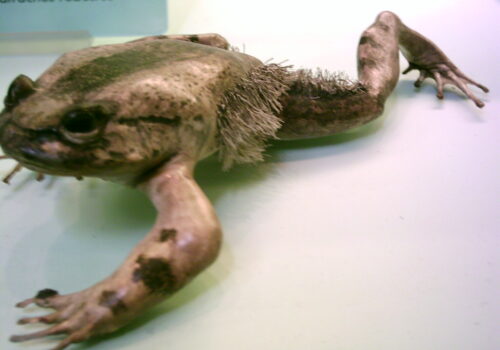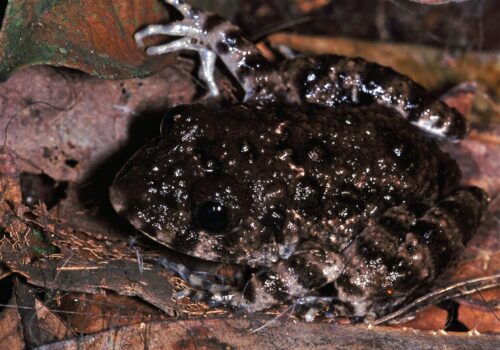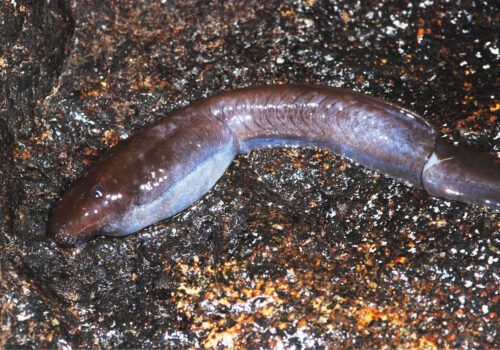- The Hidden Jewel of Africa’s Forests: Uncovering the Secrets of the Leptopelis notatus Frog
- Taxonomy and Classification
- Natural Habitat: Life in the Leafy Canopies
- Physical Characteristics: A Tiny Forest Phantom
- Behavior and Life Cycle: Songs in the Moonlit Canopy
- Ecological Role: Guardians of Forest Balance
- Threats and Conservation Status: A Fragile Existence Under Threat
- Cultural and Scientific Significance: Beyond Ecological Importance
- Conclusion: Preserving Africa’s Elusive Jewel
The Hidden Jewel of Africa’s Forests: Uncovering the Secrets of the Leptopelis notatus Frog#
Beneath the dense canopy of West Africa’s rich tropical forests, amid lush foliage, vibrant orchids, and gently drifting mist, lives a small amphibian seldom seen but vital to the forest ecosystem. Known to science as the Leptopelis notatus, this exquisite frog delights biologists and nature enthusiasts alike with its striking appearance, distinctive calls, and fascinating behaviors.
Also referred to commonly as the Spotted Forest Tree Frog, Leptopelis notatus belongs to the vast and fascinating amphibian family Arthroleptidae, a diverse lineage of frogs often adapted to arboreal lifestyles. Not just another pretty amphibian, the Spotted Forest Tree Frog acts as a vital indication of ecological health in its West African forest surroundings, serving as nature’s sensitive thermometer for detecting environmental shifts.
Taxonomy and Classification#
Frogs, remarkably diverse and numerous, find themselves sorted by scientists into intricate patterns of relatedness. Leptopelis notatus fits neatly within the Arthroleptidae family, more specifically within the genus Leptopelis. This genus encompasses dozens of tree frog species, each uniquely adapted and showcasing distinct evolutionary paths. The genus name “Leptopelis” literally translates as “slender climber,” a hallmark of the graceful, arboreal lifestyle for which these frogs have evolved.
The Spotted Forest Tree Frog, scientifically described as Leptopelis notatus, was first studied and cataloged in great detail by biologists in the late 19th century. Closely related species within this genus vary significantly, but the group’s shared features of arboreal habitat and vibrant coloration make them stand out among amphibian enthusiasts who traverse the rain-soaked landscapes to observe them.
Natural Habitat: Life in the Leafy Canopies#
Spanning several countries including Nigeria, Cameroon, Equatorial Guinea, Gabon, and the Republic of Congo, Leptopelis notatus thrives in the lush and humid rainforests of West-Central Africa. These forests, teeming with life, provide a rich tapestry of greenery, moisture, and warmth—a paradise ideally suited to the Spotted Forest Tree Frog’s delicate ecological requirements.
A Canopy-Dwelling Lifestyle#
Unlike many frogs that inhabit streamsides or forest floors, the Spotted Forest Tree Frog prefers the lofty heights of the forest canopy. Here, amid twisted branches blanketed with moss, lichen, and epiphytes, these frogs find an abundance of shelter and food sources. They navigate this complex three-dimensional habitat with impressive agility, their specialized limbs allowing them to leap confidently through the forest’s highest branches.
The rainforest’s humidity and consistent rainfall ensure ideal breeding conditions for Leptopelis notatus. Seasonal rains trigger dramatic choruses of males calling enthusiastically from tree branches, serenading prospective mates beneath the silver light of tropical moonlit nights.
Physical Characteristics: A Tiny Forest Phantom#
A diminutive amphibian rarely exceeding 6 centimeters, Leptopelis notatus nevertheless exudes undeniable charm and beauty. Its lithe frame and large, expressive eyes grant it a remarkably attentive and almost intelligent appearance, as if forever alert to its rainforest surroundings. This arboreal frog possesses prominent sticky toe pads, evolved to cling effortlessly to slick leaves and exposed bark—an indispensable adaptation for a creature that spends nearly its entire life among tree branches.
An Artistic Palette of Colors and Patterns#
Perhaps the standout characteristic of Leptopelis notatus is its stunning coloration. A mosaic of greens, browns, yellows, and occasional vivid splashes of bright orange adorns its slender body, a diverse patterning that helps each individual blend seamlessly with its forest surroundings. These colors aren’t just aesthetic; they are essential camouflage, allowing the frog to evade predators like tree snakes, projecting its silhouette as nothing more than a leaf dappled with shade.
Intricately patterned spots along its back inspire its common name—each marking unique as a human fingerprint, assisting researchers in identifying individuals during population studies.
Behavior and Life Cycle: Songs in the Moonlit Canopy#
As twilight descends upon the lush West African forests, a symphony emerges from the canopy—a cacophony of clicks, whistles, and melodic chirps. Central to this nightly orchestra, Leptopelis notatus males vocalize persistently from their arboreal perches. These calls are crucial tools in the complicated social dynamics of frog breeding, serving to attract females and assert territory dominance among rival males.
A Romantic Rainfall Ritual#
The approach of rainy seasons signals the peak breeding activity for Spotted Forest Tree Frogs. Males expend considerable energy calling repeatedly to attract mates during moist, warm evenings. Upon successful courtship, the female deposits eggs high among moist leaves or in shallow water pockets held in plant leaf axils. Unlike terrestrial frogs that lay vast egg clutches in water bodies, Leptopelis notatus produces fewer eggs, carefully placed away from ground-level predation pressures.
The resulting tadpoles eventually emerge, finding their initial aquatic refuge within rainwater-filled tree hollows, slowly transforming under protective cover. This arboreal developmental pathway mitigates the risk of predation faced by their more terrestrial counterparts, showcasing an ingenious evolutionary solution to survival challenges presented by the rainforest ecosystem.
Ecological Role: Guardians of Forest Balance#
Despite its small stature, Leptopelis notatus significantly influences forest ecology. Acting as both predator and prey, these frogs maintain delicate ecological balances crucial to rainforest health. Their insectivorous diet helps regulate insect populations—especially beetles, moths, and flying ants—contributing indirectly to the health of plants by reducing herbivorous insect numbers.
In turn, these frogs form vital prey for numerous forest predators, including birds, snakes, and larger amphibians. Each individual frog plays a small but significant part in sustaining the intricate web of life within these forests. Furthermore, due to their sensitivity to environmental changes, tree frogs like Leptopelis notatus serve ecologists as “bioindicators,” reflecting overall ecosystem health with startling sensitivity.
Threats and Conservation Status: A Fragile Existence Under Threat#
Currently listed as “Least Concern” on the IUCN Red List, Leptopelis notatus nonetheless confronts increasing threats associated with deforestation, human encroachment, and environmental degradation. Logging activities, agriculture expansion, urbanization, and climate change pose escalating risks to rainforest ecosystems, impacting these small amphibians disproportionately given their specialized habitat needs.
Emerging diseases, such as chytridiomycosis, also present serious threats to amphibian populations globally, and researchers remain vigilant tracking its presence across West African frog populations. Conservationists advocate for habitat protection and sustainable land-use practices to secure the future of this charismatic frog species and the intricate ecosystems that support it.
Cultural and Scientific Significance: Beyond Ecological Importance#
In numerous cultures throughout West Africa, frogs embody symbolic representations of fertility, renewal, and rain-associated folklore traditions. Amphibians such as Leptopelis notatus appear prominently in folklore tales, representing transformation, rebirth, and cycles of nature.
Scientifically, further study of Leptopelis notatus offers potential insight into environmental changes, biodiversity conservation strategies, and the connections between amphibian health and human-driven impacts on ecosystems. Such studies provide invaluable data for crafting global conservation efforts, aligning scientific research with conservation action.
Conclusion: Preserving Africa’s Elusive Jewel#
In each delicate chirp from forest treetops, and each flash of vibrant coloration among leaves, Leptopelis notatus reminds us of nature’s fragile beauty. Through mindful conservation, ongoing research, and public awareness, we can ensure that future generations experience the thrill of uncovering the hidden jewels of our planet’s remarkable forest ecosystems.
Let our admiration for this tiny amphibian deepen our commitment to conservation. Let us celebrate, protect, and ultimately preserve the intricate tapestry of life sustaining Africa’s Spotted Forest Tree Frog.


